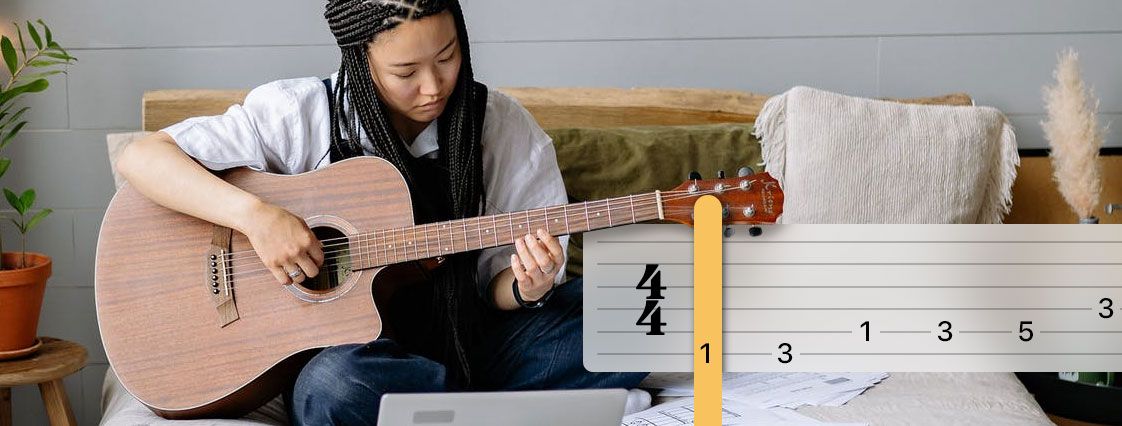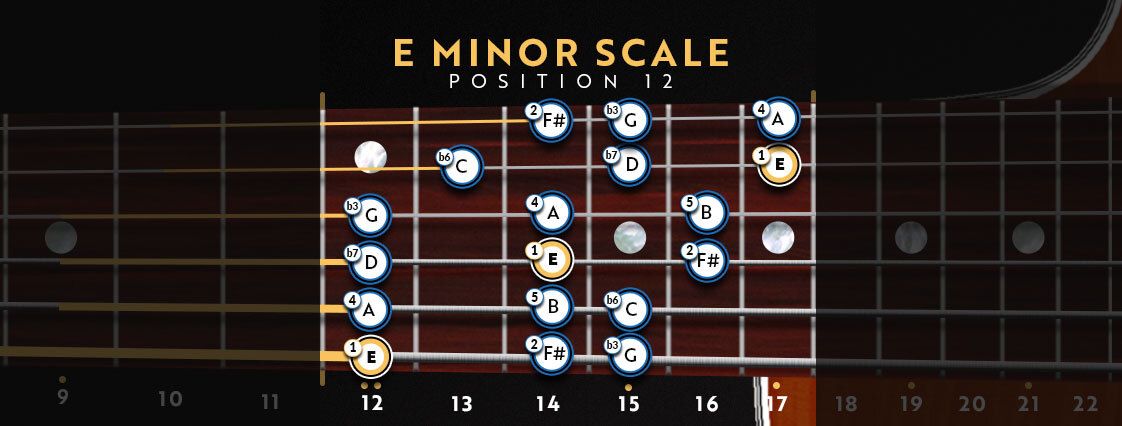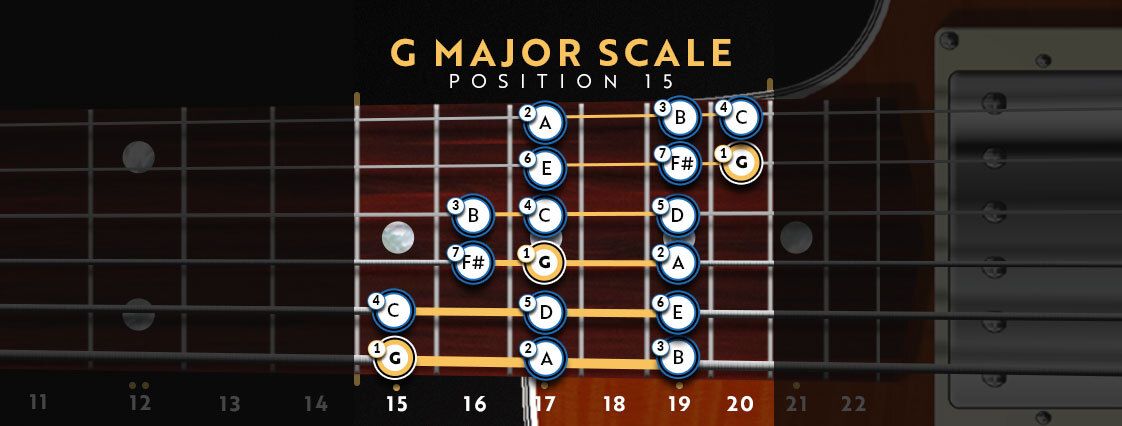Many beginners often wonder why they should practice guitar scales. With the TABs telling you exactly what to play it may seem pointless learning them. Plus, large books of scale patterns can be intimidating, putting you off altogether. With this in mind, you can be left wondering: Do I really have to learn scales to become proficient at playing guitar?
Well, if you want to learn how to improvise, better memorize guitar solos, and learn how to compose your own riffs, the answer is yes.
But, choosing which scales to learn as a beginner can be overwhelming. So, in this article, you’ll learn the three best guitar scales to practice for beginners. Once you’ve learned these three guitar scales, you’ll not only start to unlock your fretboard, but you’ll have a roadmap you can use to start exploring some more advanced musical concepts.
Why Learning Scales On Guitar Is Important
It’s important to see intervals, chords, and scales as the raw material of all music. The notes that comprise many scales and chords are often the foundation to the melodies you sing along to, the musical structures of your favorite songs, and the source of many iconic riffs and solos.
Right now though, you probably see the guitar as a few chord shapes and many arbitrary numbers that comprise the riffs you’re learning. The more you practice guitar scales daily and identify them in the music you’re playing, the more quickly you’ll learn new material and progress as a player.
Simply put, learning scales will help you more easily memorize lots of guitar solos and riffs!
But What Actually Are Scales?

A scale is just a group of notes played together in a sequence. That’s it! These groupings are often in 5 notes (pentatonic) or 7 notes, with a maximum of 12 notes being played together in a single scale.
The real fun arrives when we decide which of these 5 or 7 of these notes to put together. As you can imagine, there are thousands of possible combinations and that’s why the scale books are often so thick.
Most scales get their individual sound thanks to the mixture of different distances between the notes, which we call “intervals.” An interval is just a word we use to describe the distance between two notes, like the E and F notes or the G and A notes, for example.
We have names for each interval like the major and minor 3rd, for instance. However, it’s not necessary to know the intervals and construction of the scale to start playing them.
Thankfully, there’s only a few types of scales that are most commonly used: The minor and major pentatonic scales, the major scale, and the minor scale. We use these the most in western harmony because they provide us with many of the chords we use in western music.
What Guitar Scales To Practice As A Beginner
The musical theory behind intervals, scales, and chords can get quite complex. However, no matter how you may feel about theory, each piece of music you come across will use some mixture of intervals that we can identify as a particular scale or chord.
That being said, we’re now going to discuss the minor pentatonic scale, the minor scale, and the major scale. You’re going to see how they’re interconnected and why these guitar scales are so important for a beginner to learn first.
What Are The Differences Between Scale Patterns And Positions?
Let’s talk briefly about what a “pattern” is and what a “position” is.
There are commonly between 20-24 frets on a guitar neck. The tabs you use will use numbers to identify what frets your fingers should be playing notes in at any given time. So, a “position” simply shows you which fret to play in. For example, the 5th position means the 5th fret, and the open position (number 0) means to play at the open position.
A “pattern” means a specific set of notes played in a certain position. There are several common patterns we use for many guitar scales. We’ll now take a look at which scales you should learn first as you start learning guitar.
Scale 1: The E Minor Pentatonic Scale At The 12th Position

Many beginners should learn this scale pattern first as many iconic solos use this pattern! Jimi Hendrix, David Gilmour, Stevie Ray Vaughan, Jimmy Page, Slash, and so many others have used this pattern as a jump off point for their riffs and/or solos.
Why You Should Start With The E Minor Pentatonic Pattern In Open Position And 12th Position
Because the guitar is tuned to E, the minor pentatonic scale is perfectly suited to beginners. Lots of music on the guitar uses this scale because they come from the set of notes the scale uses: E - G - A - B - D.
Pay close attention to those notes as we move on to the next guitar scale to practice, the E minor scale.
How To Play E Minor Pentatonic Pattern In Position 12
This scale is a great one to learn as it’s easy to play. All of the notes on the 12th fret will be played with your first finger. All the other notes on the 14th or 15th frets can be played with your ring finger or pinky. In the open position, you would just pick the open notes wherever you see a '0.' This pattern is played exactly the same way in the open position!
This scale is a fundamental part of many rock riffs so getting this fingering down is important!
Scale 2: The E Minor Scale In Position 12

Remember how the notes of the E minor pentatonic scale were E - G - A - B - D? Well all we’re doing here is adding two more notes, the F# and C, to make it a 7 note scale. When you compare the E minor pentatonic scale and the E minor scale you can see that they’re basically the same scale.
The minor scale is important to know because it forms the basis of many heavy metal solos and riffs, as well as the foundation of hundreds of melodies and chord progressions too. It’s also closely related to the major scale as you’ll see in one of the next sections.
How To Play The E Minor Scale In Position 12
To play this scale pattern, you’ll use almost exactly the same fingerings as in the pentatonic pattern, except you’ll use your middle finger much more. Depending on whether you like to play using your pinky, you will play either 1-3-4 or 1-2-3 on all the strings. 1 means using your index/first finger, 2 means your middle finger or 2nd finger, etc. Lots of tabs will tell you which fingers should go where, but in this case, it’s optional to use your pinky.
The one curveball about this scale pattern is the figure on the G string where you play 11-12-14 (that’s frets, not your finger positions). You will need to prepare your 1st finger to reach the 11th fret when hitting the G string, and then you’ll have to prepare your first finger to go back to the 12th fret on the B string when playing 12-13-15.
Scale 3: The G Major Scale In Position 15

Many guitarists are told to learn the C major scale when starting out, but this isn’t always the most logical scale for a beginner to learn first. This is because when you learn C major after learning E minor pentatonic, you’ll be trained to see them as separate and unrelated to the pentatonic and minor scales.
The G major’s relative major scale is E minor, which you can see when looking at all the notes it contains. So, all that’s happened here is we’ve taken the pentatonic scale notes, added two more notes, and played them all starting on a different note. To easily find any relative major or minor scale, either start on the 6th note of a major scale (for the relative minor), or the 3rd note of a minor scale (for the relative major).
A final thing to mention is that you must remember that these are patterns. If you play any of these patterns at other positions of the neck, you will get another minor or major scale. At the 2nd fret using the pentatonic, you’ll get the F# minor pentatonic scale. Play the major scale pattern on the 8th position, and you’ll get the C major scale. Take the time to learn the notes of the fretboard and play these scales at various positions. Playing these three patterns one after another is a great guitar scale exercise.
Tips For Improving Your Scale Playing Skills
- Try to place your fingers right behind the metal fret marker. This will help you avoid making any fret noise and you’ll create a fuller sound when playing.
- When practicing any new scale patterns, be sure to start and end on the “root” note, which just means the starting note of the scale. Even though the patterns we’ve talked about are the same thing in a way, they do have a different sound because of the different sequence of notes being played.
- Strive to find the best fingering positions with each pattern you play. This will train you to learn difficult lead licks later on. Don’t use the same finger to play all the notes or use just two fingers per string when three or four may be better.
- Focus on learning the patterns slowly at first! You can’t play the notes fast if you haven’t memorized them yet and doing so will interfere with your brain’s muscle memory. Once your finger and arm muscles have adapted to the fingerings, you won’t have to think about them so much and your natural playing instincts will start to take over.
- Invest in a metronome and practice playing these patterns at slow tempos before increasing the speed. If you’re not sure how to practice with a metronome, then please watch this lesson: Playing Scales With A Metronome (from the Intermediate Method).
So, what's the next step?
Congratulations! You’ve learned more about scales than most guitar players ever will. Hopefully it wasn’t that hard. Music theory is a rich body of knowledge that will unlock many of the secrets to making music.
If you’re looking for a serious way to take your guitar playing to the next level, you can try out the Fretello app for free. Here, you’ll learn the basics and beyond using a step-by-step Learn Path and improve quickly thanks to the app's real-time feedback.
